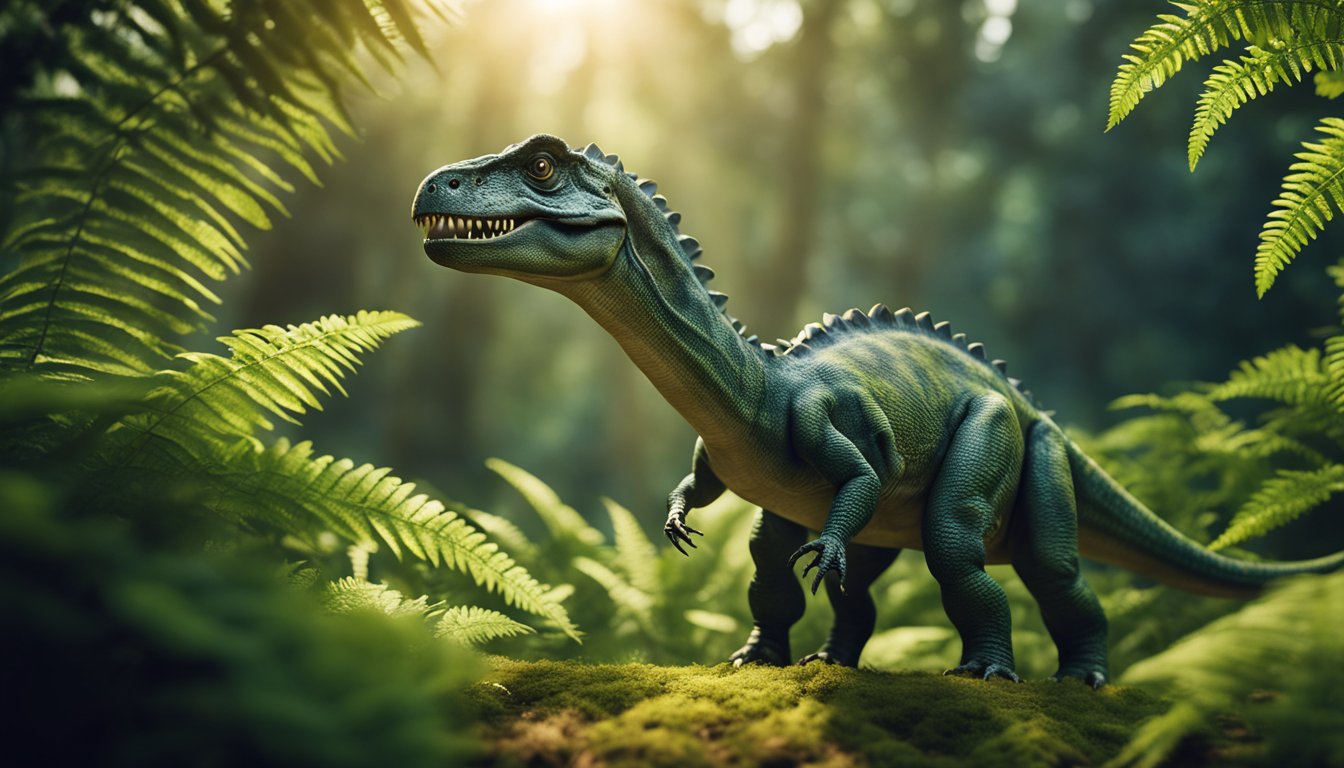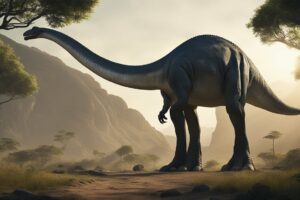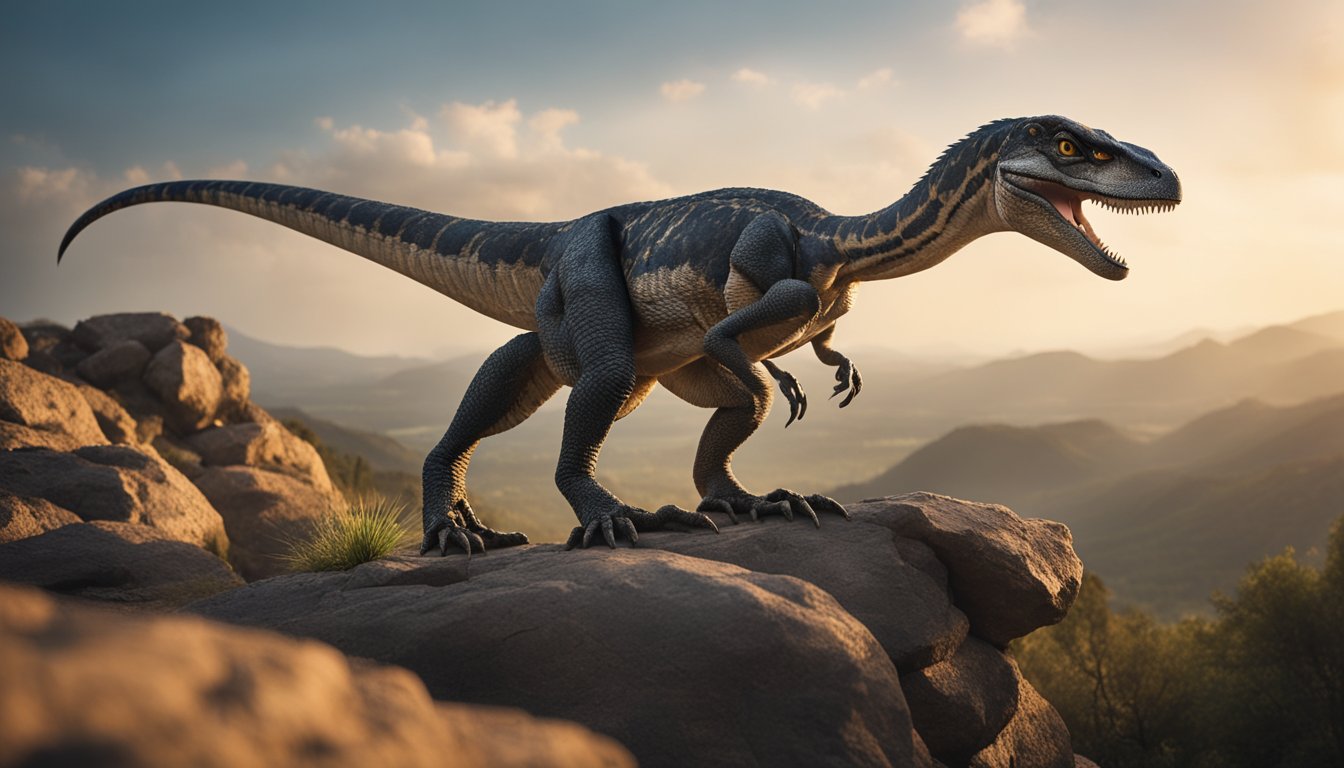Aquilops, North America’s tiny horned dinosaur, is a fascinating creature that has captured the attention of paleontologists and dinosaur enthusiasts alike.
This small cat-sized dinosaur lived during the Early Cretaceous epoch, about 108 million years ago, and is the oldest known horned dinosaur from North America.
Aquilops lacked horns and a bony neck frill, unlike its famous relatives such as Triceratops.

The discovery of Aquilops americanus has provided important new information on vertebrate history during the latter part of the age of dinosaurs.
Scientists have found that Aquilops is now considered the oldest member of the horned dinosaur lineage named from North America.
The expedition team’s findings were published in the scientific journal PLOS ONE, which has helped to further our understanding of the evolution of horned dinosaurs in North America.
Despite its small size, Aquilops is a significant discovery in the field of paleontology.
Its discovery has helped scientists to better understand the diversity of horned dinosaurs in North America during the Early Cretaceous epoch.
With its rabbit-like appearance and lack of horns, Aquilops is a fascinating creature that has captured the imagination of people of all ages.
Unearthing Aquilops Americanus
The Discovery in Montana
In 1997, a team of paleontologists led by Rich Cifelli from the Sam Noble Museum embarked on an expedition funded by the National Geographic Society’s Committee for Research and Exploration to Montana.
During this expedition, they made a remarkable discovery: the fossilized remains of a tiny horned dinosaur, which they named Aquilops americanus.
The fossils were found in the Cloverly Formation, a rock layer that dates back to the Early Cretaceous period, about 108 million years ago.
The discovery of Aquilops was significant because it represented the oldest known horned dinosaur from North America.
The fossils included a nearly complete skull, parts of the jaw, and a few bones from the neck and back.
The skull was only about the size of a tennis ball, and the entire animal was estimated to have been about the size of a house cat.
Despite its small size, Aquilops had a distinctive feature: a pair of small horns above its eyes.
A Journey from Asia
Aquilops belongs to a group of dinosaurs called ceratopsians, which includes the well-known Triceratops.
However, unlike Triceratops, Aquilops was a much smaller and more primitive member of the group.
Scientists believe that Aquilops may have evolved in Asia and migrated to North America during the Early Cretaceous period.
Fossils of similar dinosaurs have been found in Asia, including a species called Yamaceratops, which lived in what is now Mongolia around the same time as Aquilops.
The discovery of Aquilops sheds light on the evolution of horned dinosaurs and their migration patterns.
It also highlights the importance of continued paleontological research, which can uncover new and exciting information about the natural world.
Fun fact: The name Aquilops means “eagle face” in Latin, a reference to the bird-like shape of its skull.
A Glimpse into the Cretaceous Era

Life in Early Cretaceous Earth
The Cretaceous Era, which lasted from 145 to 66 million years ago, was a time of great change for life on Earth.
The climate was warm and humid, and the continents were still moving into their current positions.
The Early Cretaceous period, which spanned from 145 to 100 million years ago, was marked by the emergence of new species of plants and animals.
During this time, dinosaurs were the dominant land animals, with some of the most famous species such as the Tyrannosaurus Rex and the Triceratops.
The ecosystem was also home to smaller dinosaurs such as the Aquilops, which was about the size of a rabbit and weighed around 3.5 pounds.
Ceratopsians: A Flourishing Family
The Ceratopsians were a family of dinosaurs that lived during the Cretaceous Era.
They were characterized by their elaborate frills and horns on their heads, which were used for display and defense.
The most famous member of this family is the Triceratops, which lived during the Late Cretaceous period.
Aquilops, on the other hand, was a primitive member of the Ceratopsian family that lived during the Early Cretaceous period.
Unlike its larger relatives, Aquilops lacked the trademark head shield and facial horns.
It was a “no frills” Ceratopsian, but it was still an important discovery for paleontologists because it was the oldest known species of horned dinosaur from North America.
The discovery of Aquilops sheds light on the early evolution of Ceratopsians and their migration to North America.
It also provides a glimpse into the diversity of life during the Early Cretaceous period.
Aquilops’s Anatomy and Lifestyle

Distinct Features and Size
Aquilops Americanus, also known as the tiny horned dinosaur, was discovered in 2014 by a group of paleontologists.
This herbivorous dinosaur was about the size of a rabbit, weighing only around 3.5 pounds and measuring around 2 feet in total length.
Unlike its famous relatives, such as Triceratops, Aquilops lacked horns and a bony neck frill.
Instead, it had a small beak and teeth that were perfect for nibbling on vegetation.
One of the distinct features of Aquilops was its skull, which was named American eagle face.
It represents a 3-pound relative of Triceratops, which weighed up to 4,000 times more.
The skull was small, measuring only about 3 inches long, and had large eyes that helped Aquilops spot predators.
Diet and Behavior
Aquilops was a herbivore, which means it only ate plants.
Its diet consisted of ferns, cycads, and other vegetation that grew in the lush forests of what is now southern Montana during the Early Cretaceous epoch, about 108 million years ago.
Aquilops had a unique way of feeding.
It had a beak that was perfect for snipping off leaves and stems, and its teeth were used to grind the vegetation into smaller pieces.
Aquilops was also able to move its lower jaw in a circular motion, which helped it chew its food more efficiently.
Despite its small size, Aquilops was a fast runner and was able to escape from predators such as small carnivorous dinosaurs.
It is believed that Aquilops lived in small herds, which provided protection from predators and helped with finding food.
In conclusion, Aquilops Americanus was a fascinating dinosaur that had unique features and behaviors.
Its small size and herbivorous diet made it stand out from its larger and more carnivorous relatives.
The Legacy of America’s Tiny Horned Dinosaur

Impact on Science and Culture
The discovery of Aquilops Americanus, the oldest known species of horned dinosaur from North America, has had a significant impact on the fields of paleontology and evolution.
The discovery, made in the Judith River Formation in Montana, was published in the scientific journal PLOS ONE, and has provided important new information on vertebrate history during the latter part of the age of dinosaurs.
Aquilops Americanus is a member of the group called Ceratopsian dinosaurs, which includes famous relatives such as Triceratops.
Unlike its relatives, however, Aquilops Americanus lacked horns and a bony neck frill.
It was about the size of a rabbit, weighing around 3.5 pounds (1.6 kilograms) and measuring around 2 feet (60 centimeters) in total length.
The discovery of Aquilops Americanus has sparked renewed interest in the study of horned dinosaurs and their evolution.
Paleontologists are now actively conducting research to better understand the origins and relationships of these fascinating creatures.
Conservation and Continuing Research
The Raymond M. Alf Museum of Paleontology and the Sam Noble Oklahoma Museum of Natural History are two institutions that are actively engaged in the conservation and research of horned dinosaurs, including Aquilops Americanus.
These museums are dedicated to preserving and studying the fossils of these ancient creatures, and to educating the public about their importance in the history of life on Earth.
Continuing research on Aquilops Americanus and other Neoceratopsian and Ceratopsian dinosaurs is essential to our understanding of the evolution of these fascinating creatures, and to the history of life on Earth.
By studying their fossils and reconstructing their habitats and behaviors, paleontologists are able to piece together a picture of the past and gain insights into the workings of the natural world.
In conclusion, the discovery of Aquilops Americanus has had a significant impact on the fields of paleontology and evolution, sparking renewed interest in the study of horned dinosaurs and their evolution.
The continued conservation and research of these fascinating creatures is essential to our understanding of the history of life on Earth.
Frequently Asked Questions

What era did Aquilops live in?
Aquilops lived during the Early Cretaceous period, about 108 million years ago.
This was a time when the Earth was very different from what it is today, with a warmer climate and different species of plants and animals.
How does Aquilops compare in size to other horned dinosaurs?
Aquilops is one of the smallest known horned dinosaurs, about the size of a rabbit.
It weighed around 3.5 pounds (1.6 kilograms) and measured around 2 feet (60 centimeters) in total length.
Unlike its famous relatives, such as Triceratops, Aquilops lacked horns and a bony neck frill.
What did Aquilops eat during its time on Earth?
Aquilops was a herbivore, which means it ate plants. Scientists believe that it likely fed on ferns, cycads, and conifers.
Its sharp beak was adapted for snipping vegetation, and its teeth were used for grinding up tough plant material.
Can you describe the unique features of Aquilops?
Aquilops is known for its distinctive skull, which is small and triangular in shape.
It also has a unique combination of primitive and advanced features that make it an important link in the evolution of horned dinosaurs.
For example, it has a small horn-like projection on its forehead, which may have been a precursor to the elaborate horns and frills seen in later ceratopsians.
Where were the fossils of Aquilops discovered?
The fossils of Aquilops were discovered in Montana, USA, in rocks that date back to the Early Cretaceous period.
The discovery was made by a team of paleontologists led by Dr. Andrew Farke from the Raymond M. Alf Museum of Paleontology.
How does Aquilops contribute to our understanding of dinosaur evolution?
Aquilops is an important discovery because it helps fill in gaps in our understanding of dinosaur evolution.
Its small size and primitive features suggest that it may be one of the earliest members of the horned dinosaur lineage.
By studying its anatomy and comparing it to other dinosaurs, scientists can learn more about how these creatures evolved and adapted over time.





